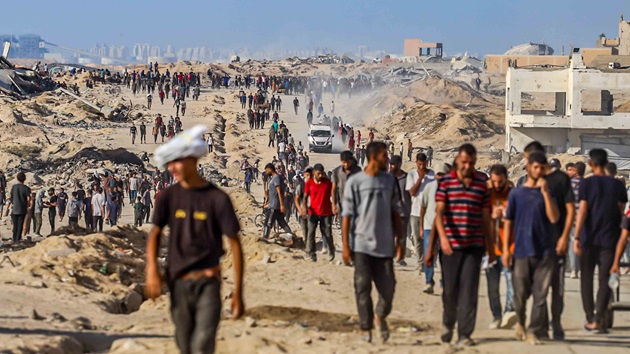
(LONDON) — At least 20 people were killed in an incident at one of the Gaza Humanitarian Foundation aid distribution sites in the southern Gaza Strip, the U.S.-backed group said in a statement on Wednesday.
The GHF said in a post to X that 19 of the dead were “trampled” and another was stabbed, in what it described as a “chaotic and dangerous surge.” The GHF blamed “agitators in the crowd” for the stampede.
The Hamas-run Ministry of Health in Gaza said that 15 of those killed “died of suffocation as a result of tear gas fired at the starving people and the subsequent stampede.” The ministry said at least 21 people were killed in the incident. The GHF denied using tear gas, saying instead that there was a “limited use” of pepper spray.
Video filmed by local journalist Abdallah Alattar and verified by ABC News appeared to show lifeless bodies being unloaded from a cart outside Nasser Hospital in Khan Younis.
A man could be seen holding a boy whose head appears to be limp and telling the cameraman, “They died by suffocation. There was a stampede.”
Marwan Al Hams, director-general of field hospitals in Gaza, told ABC News that victims arriving there showed signs of bruising on the face and body, injuries that the source said were consistent with intense crowding. Victims also showed notable indications of “oxygen deprivation,” the source said.
As of July 13, at least 875 people have been killed in recent weeks while trying to get food in Gaza, according to Thameen Al-Kheetan, a spokesperson for the U.N.’s Office of the High Commissioner for Human Rights. Of those, 674 were killed “in the vicinity of GHF sites,” Al-Kheetan said.
The GHF is backed by the U.S. and Israeli governments, with the U.N. and other aid organizations refusing to collaborate with the group, citing concerns about its transparency and political impartiality.
The GHF has consistently rejected criticisms by the U.N. and other aid groups of its aid distribution operations and multiple deadly incidents occurring among groups of Palestinians on their way to collect food.
In its statement on Wednesday’s deadly stampede, the GHF said it had “credible reason to believe that elements within the crowd — armed and affiliated with Hamas — deliberately fomented the unrest.”
“For the first time since operations began, GHF personnel identified multiple firearms in the crowd, one of which was confiscated,” the group alleged. “An American worker was also threatened with a firearm by a member of the crowd during the incident.”
“We mourn the lives lost today, and we remain committed to providing humanitarian aid as safely and responsibly as possible,” it added. “GHF exists to serve the people of Gaza with compassion and integrity, and our mission has never been more urgent or more challenged.”
The Hamas-run Government Media Office in Gaza issued a statement rejecting the GHF allegations.
This week, the GHF unveiled a new “flag system” to indicate the status of its sites to Palestinians seeking aid. A red flag will be flown to signify that the site is closed, while a green flag will indicate it is open, the group said in a Monday post to social media.
The Israeli government says the GHF is required to prevent Hamas fighters from seizing humanitarian aid, which Israel has accused the terror group of throughout the war in Gaza. Hamas has denied such thefts.
On Saturday, the Israel Defense Forces told ABC News in a statement that it “allows the American civilian organization (GHF) to distribute aid to Gaza residents independently, and operates in proximity to the new distribution zones to enable the distribution alongside the continuation of IDF operational activities in the Gaza Strip.”
Previous deadly incidents attributed to Israeli military action at or near the GHF sites, the IDF said, “are under review by the competent authorities in the IDF.”
Hungry Palestinians say they have to go to the sites to collect aid, with few other options.
“How can I go and buy 1 kg of flour for 70 shekels ($20) when I don’t have that kind of money?” Mohanned Al Tifi, awaiting treatment inside Nasser Hospital, told ABC News on Wednesday morning. “This is what forced me to go there, the hunger.”
Al Tifi said he suffered a pelvic fracture in the morning’s chaos. He had to wait for 3 hours before he was helped to safety at the aid site by a “good Samaritan,” he said.
“Let me tell you if I could bring 5 kg of flour I will go home happy,” he said.
Copyright © 2025, ABC Audio. All rights reserved.

